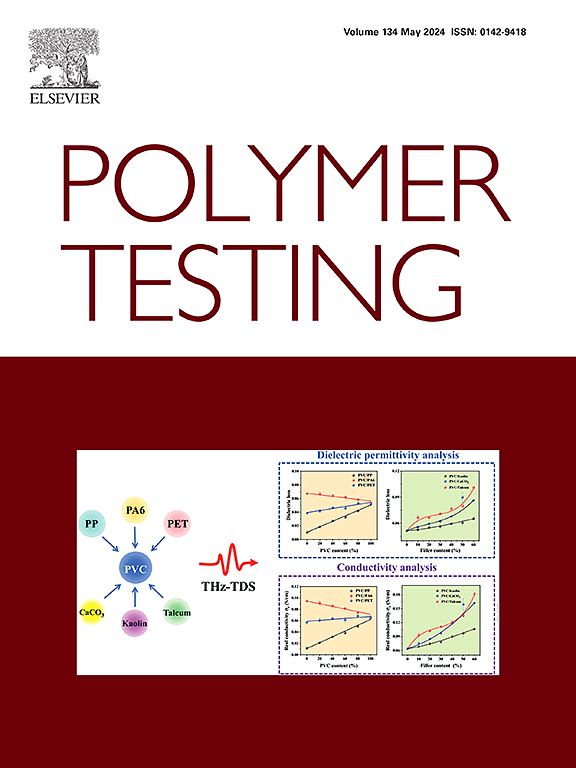Enhanced mechanical properties of biodegradable poly(butylene adipate-co-terephthalate) through naphthalate incorporation
IF 5
2区 材料科学
Q1 MATERIALS SCIENCE, CHARACTERIZATION & TESTING
引用次数: 0
Abstract
Poly(butylene adipate-co-terephthalate) (PBAT) serves as a viable substitute for low-density polyethylene (LDPE), particularly in agricultural films and packaging. However, for broader application of PBAT, extensive research has been conducted to fundamentally enhance its mechanical properties. This study introduces a novel PBAT copolymer that incorporates naphthalate content to enhance mechanical performance by partially replacing terephthalate content with rigid aromatic naphthalate content. Synthesized via a two-step melt polymerization method with varying dimethyl 2,6-naphthalenedicarboxylate (DMN) content (0–100 mol% relative to the total phthalate content), the copolymer demonstrated a significant increase in tensile strength, reaching 56.01 MPa for PBATN80, compared to 14.43 MPa for pure PBAT, while maintaining elongation at break between 530 % and 743 %. X-ray diffraction analysis revealed that the crystalline structure of the copolymers changed in response to increasing naphthalate content; specifically, samples with naphthalate content exceeding 50 mol% exhibited distinct peaks associated with poly(butylene-2,6-naphthalate). This enhancement in their mechanical properties is believed to be attributed to the similarities in characteristics with poly(butylene naphthalate) (PBN). Importantly, biodegradability was preserved, albeit at slightly reduced rates. This research highlights a promising strategy to enhance mechanical properties of PBAT without compromising its biodegradable nature, suggesting its potential for sustainable applications.
通过萘二甲酸酯掺入提高可生物降解聚己二酸丁二酯-对苯二甲酸酯的机械性能
聚己二酸丁二醇酯(PBAT)是低密度聚乙烯(LDPE)的可行替代品,特别是在农用薄膜和包装中。然而,为了使PBAT得到更广泛的应用,人们进行了大量的研究,从根本上提高其力学性能。本研究介绍了一种新型PBAT共聚物,该共聚物采用刚性芳香族萘二甲酸酯含量部分取代对苯二甲酸酯含量,以提高机械性能。采用两步熔融聚合法制备了DMN含量(相对于邻苯二甲酸酯总含量为0-100 mol%)不同的共聚物,PBATN80的抗拉强度显著提高,达到56.01 MPa,而纯PBAT的抗拉强度为14.43 MPa,断裂伸长率保持在530%至743%之间。x射线衍射分析表明,随着萘二甲酸盐含量的增加,共聚物的晶体结构发生了变化;特别是,萘二甲酸酯含量超过50 mol%的样品显示出与聚(丁烯-2,6-萘二甲酸酯)相关的明显峰。这种机械性能的增强被认为是由于与聚萘二甲酸丁二酯(PBN)的特性相似。重要的是,生物降解性得到了保留,尽管速率略有降低。这项研究强调了一种有前途的策略,可以在不影响PBAT生物降解特性的情况下提高其机械性能,表明其具有可持续应用的潜力。
本文章由计算机程序翻译,如有差异,请以英文原文为准。
求助全文
约1分钟内获得全文
求助全文
来源期刊

Polymer Testing
工程技术-材料科学:表征与测试
CiteScore
10.70
自引率
5.90%
发文量
328
审稿时长
44 days
期刊介绍:
Polymer Testing focuses on the testing, analysis and characterization of polymer materials, including both synthetic and natural or biobased polymers. Novel testing methods and the testing of novel polymeric materials in bulk, solution and dispersion is covered. In addition, we welcome the submission of the testing of polymeric materials for a wide range of applications and industrial products as well as nanoscale characterization.
The scope includes but is not limited to the following main topics:
Novel testing methods and Chemical analysis
• mechanical, thermal, electrical, chemical, imaging, spectroscopy, scattering and rheology
Physical properties and behaviour of novel polymer systems
• nanoscale properties, morphology, transport properties
Degradation and recycling of polymeric materials when combined with novel testing or characterization methods
• degradation, biodegradation, ageing and fire retardancy
Modelling and Simulation work will be only considered when it is linked to new or previously published experimental results.
 求助内容:
求助内容: 应助结果提醒方式:
应助结果提醒方式:


